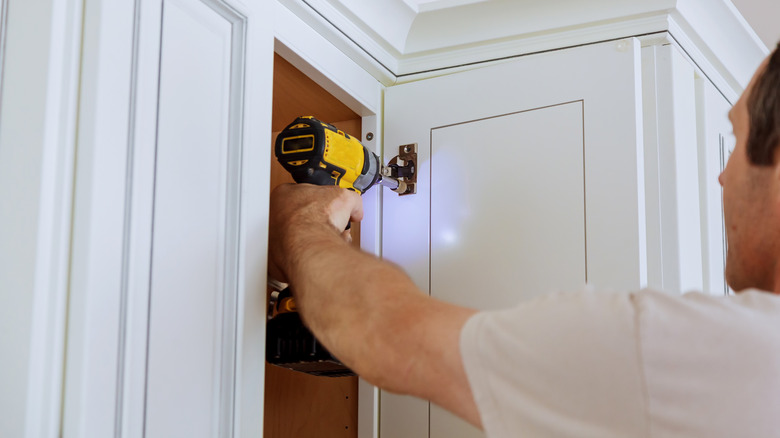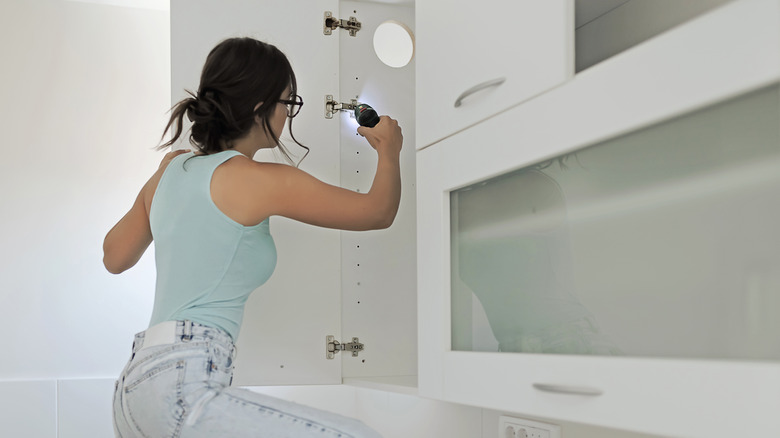The Essential Step That'll Help When Putting Painted Cabinets Back Together
Repainting your kitchen or bathroom cabinets is one of the simplest ways to totally transform an entire room — but the process itself is anything but simple. Haphazardly painting over cabinets can make them look sloppy and even cause functional problems for doors and drawers. Instead, you'll have to take apart the cabinets, sand away the old paint or stain, smooth out the wood, then prime, paint, and allow it to dry. Just when you think you're over the hump, you'll realize you still have to puzzle them back together. Wait ... does this drawer go by the fridge or the oven? Which way did these hinges swing again? And does this door belong on the upper or lower cabinets?
Before you even think about picking up your paintbrush, use a simple number and letter labeling system to make putting cabinets back together an easier process. Cabinet doors and drawers should have a number, and each hinge should have a letter. Here's how you can establish this straightforward labeling system to have your cabinets back together in minutes.
Label now, thank yourself later
You can label your cabinet parts however you'd like, but we recommend keeping things simple. Start by counting your upper wall cabinets from left to right, assigning each cabinet "box" with a number. Do the same for your lower cabinets and drawers, picking up where you left off from left to right around the room. For example, if you have 10 upper cabinets and eight lower cabinets and drawers, you'll label them one through 10 above and 11 through 18 below. For cabinets with one door, give the door the same number. If a cabinet has two doors, write 1L or 1R on each one. What about hinges, the trickiest parts to remember? Now that you have a system, you can pinpoint exactly where each hinge belongs. Use the letter "a" for upper hinges and "b" for lower hinges. To put a whole cabinet together, your parts might include box 1, doors 1L and 1R, and hinges 1La, 1Lb, 1Ra, and 1Rb.
To label your cabinet parts, use a pencil or permanent marker to write the number in a hidden spot. On doors, write it on the back where the hinges attach and cover the number. Write the same number on a piece of painter's tape and apply it to the inside of the box where it belongs. For hinges, you can either write the number on the backside of the hinge, wrap them with labeled masking tape, or toss them in labeled plastic bags.
More tips for rebuilding your cabinets
Labeling your cabinet pieces is a crucial step because each screw and hinge may sit slightly differently, especially after years of use. Putting a 1Ra screw in the 3Lb spot could cause the door to feel slightly stiff, crooked, or loose. As you're sanding, priming, and repainting your cabinet doors and drawers, take note of where their identification label is located. If needed, cover your numbers with a piece of painter's tape, like Frog Tape, to prevent them from being sanded away or covered with paint or primer. When you're finished painting, remove it before it dries to prevent sealing your painter's tape to the cabinet. Once your cabinet pieces are completely dry and you've repainted the wall boxes, attach the doors, drawers, and hinges back onto their designated boxes.
Working in order from left to right around the room will help you keep everything organized and avoid part mix-ups, even if pieces are labeled. Stow screws, hinges, drawer slides, and other small parts near their relative boxes so you won't have to sort through a pile looking for all of cabinet 1's small parts. To make the puzzling process even easier, you can also draw out a simple cabinet map on paper.

